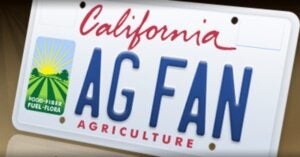With sun, sand, surf, and mountains, the Golden State of California is known for its year-round attractions. But when it comes to agricultural prowess, California tops the nation in cash receipts — so it’s not surprise that it has a farm specialty license plate to match.
This West Coast state is known for its agricultural abundance, which includes over 400 commodities and provides over a third of the nation’s supply of vegetables, fruits, and nuts. In 2022, the market value of agricultural products sold in California totaled $59.0 billion, up $13.8 billion from 2017.
While 62,900 farm operations cover over 23.8 million acres of farmland, farming operations are a meager 378 acres on average.
The top commodities in California are dairy (which tops the list at $10.40 billion), grapes, cattle, almonds, and lettuce, followed by strawberries, pistachios, broilers, tomatoes, and carrots (which still bring in $1.11 billion).
CalAg Plate supports agricultural education
The CalAg Plate, with its vibrant sun-drenched rows of crops emblazoned with “Food – Fiber – Fuel – Flora,” is one of the state’s top special-interest plates.

The CalAg Plate’s Grant Program has awarded hundreds of thousands annually to organizations to enhance their agricultural education and leadership opportunities. Each year, about $250,000 is made available for projects that support agricultural education and training. In September, organizations submit applications for grants mounts ranging from $2,500 to $212,500.
“Agricultural education represents a critical investment in the next generation of farmers, ranchers, and agricultural leaders,” said California’s Agricultural Secretary Karen Ross. “This program gives Californians the opportunity to contribute to the legacy of California agriculture and invest in its future by enriching the lives of our youngest citizens.”
The program is funded by proceeds generated by the state’s special interest, agricultural-themed license plate offered by the California Department of Motor Vehicles. To date, the program has awarded over $2 million to support agricultural education and leadership development in the state of California.
In 2013, the first CalAg Plates were issued by the DMV after a three-year effort beginning in 2010. In California, for a Special Interest Plate to be established, over 7,500 paid reservations need to be received first.
The California Department of Agriculture said, “The 2023 program was made possible by the continued efforts of many student volunteers and agricultural organizations.”
One of the CalAg Plates beneficiaries, California FFA, often holds a CalAgPlate competition in an effort to sell the most plates. Winning chapters are announced during the State FFA Convention.
About 85 percent ($250,000) of the funds earned through CalAg Plates go directly to the California FFA, which benefits the more than 95,000 FFA members who serve as a leading voice for youth development in California.
Other local, community, and state agricultural programs are awarded up to 15 percent ($37,500) of the available funding. The Tier 2 grant awards are open to entities in California that promote and administer agricultural education and leadership programs targeting K-12, post-secondary, and adult education.
Grants are awarded in three different funding categories: Agricultural education, career awareness development and training, and agricultural leadership development.
To purchase a CalAgPlate for a personal vehicle initially costs $50 and then an additional $40 a year to renew. The extra initial cost for personalized plates is $98, with a $70 annual renewal fee. These specialty plates can be put on autos, trailers, and commercial vehicles.


